Table of contents
- Suzuki GSX-R 600/750/1000 Fisherman’s Friends
- Training; Suzuki GSX-R 600
- Training; Suzuki GSX-R 750
- Run; Suzuki GSX-R 1000
- Data Suzuki GSX-R 600
- Data Suzuki GSX-R 750
- Data Suzuki GSX-R 1000
- Conclusion
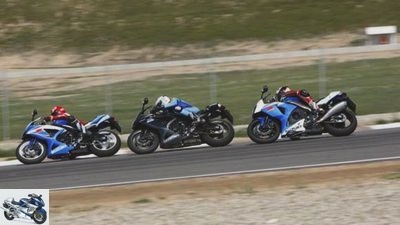
K
motorcycles
Suzuki GSX-R 600/750/1000
Suzuki GSX-R 600/750/1000
Fisherman’s Friends
Content of
If they are too strong, you are too weak. What does a hobby pilot get along with best on the racetrack: 600, 750 or 1000? Armed with the three members of the GSX-R family, the author competes in his first 3-hour race. An experience report.
Sebastian Lang
06/18/2009
Test victory in the great 2009 racetrack superbike comparison test; the new Suzuki GSX-R 1000 is a hammer. Great controllable power in abundance, good brakes, a compact seating position – a motorcycle made to burn lap times on the racetrack. Nevertheless, or precisely because of this, it can stress its pilots. Always and everywhere it goes forward, sideways or upwards, she demands maximum concentration and full physical effort.
This is probably not a problem for professionals who like to play at the limit, but for a hobby driver? Shouldn’t such recreational racetrack drivers be better off looking for their personal limits on lively, uncomplicated 600s? On motorcycles that forgive even an insensitive throttle hand and, with a little collected courage, always allow full throttle at the exit of a curve? Perhaps the interim solution is the best: Suzuki’s long-running favorite GSX-R 750 has been an integral part of the blue and white product range for decades and holds its position alone in a displacement class that has actually died out. Which of the three sisters is the most fun on the slopes??
PS boss Matthias “Scrap” Schroter decides on the only sensible answer to this question: Ex-rookie Uwe should try it out – together with the young, dynamic PS editor who still needs improving his own lap times most – with me. The venue for the family dispute is Doc Scholl’s 3-hour race as part of the PS Racecamp in Alcarràs, Spain.
But there is a long way to go before I cross the finish line for the first time: packing my tires and my clothes, driving twelve hours to Spain, unloading everything Uff. I am exhausted, the first day of training can come. And he will come.
Training; Suzuki GSX-R 600
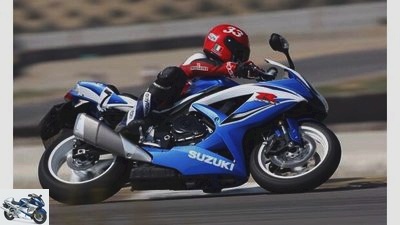
K
Suzuki GSX-R 600.
Before the first rounds in the leather suit, however, there is mental work: Find the difference. What does the 750 have that the 600 does not have? Steering damper? Have both. Three different mappings? Have both. There, after all, a small success: The compression damping of the 750 fork can be adjusted in high and low speed, that of the 600 fork is not. That’s it. Apart from the engine, I don’t find any other visible differences between the two.
The thousands make it easier for me: different design, double end pot, big piston fork. The K9 is a completely different motorcycle. It should be all the more exciting to see how the two old people compare to their younger, fat sister on the racetrack. It’s best to start small first. I grab the 600 and roll off. Everything about little Suzi looks familiar. No wonder, the base of the 600 series is already two years old. Right, right, left, through the hole, right. The new racetrack, with its long left-hand curve and rapid dip, requires getting used to.
That’s where the 600 comes in: With feather-light handling, it can still be corrected effortlessly even in an inclined position, only reacts to too high a gear at the exit of a curve with an insulted brother instead of noticeable propulsion. Next lap, now the gear fits. Little Suzi pushes linearly through the speed range in the direction of the limiter, missing the last bit of panache. The first superbikes fly past me. A Fireblade driver pushes forward on the outside and gets stuck on the GSX-R rearview mirror. Bang, the 600 wobbles, pulse 180. Nothing happens, everything is still on. I adjust the rearview mirror and drive back into the pit lane. Enough for the first turn.
A radiant, sweaty ex-rookie stands in the PS box and raves to me: “Hey, the 750 is really fun here, I’m curious how it goes on the Interacts.” I am too. Metzeler’s super sports tire Racetec Interact K3 has already proven itself in the 1000 series comparison test in Calafat (PS 4/2009) and is being compared to the competition in parallel to our race in the PS tire test by professional Angaser Arne Tode.
Training; Suzuki GSX-R 750
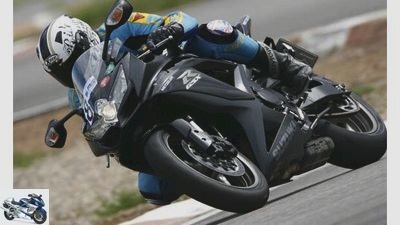
K
Suzuki GSX-R 750.
While I am peeling off my station wagon, Uwe is already removing the front wheel of the GSX-R 750. An hour later, the three Japanese sisters stand in front of the PS box, newly soled. Quitting time. Time to think. With the 600 it will be difficult to break anything in the race, especially for a newcomer to racing. With the determination to work on my personal limit on the second day of training with the 750, I fall into bed.
The next morning a soft drumming wakes me up. This can not be true. I pull back the curtain, and sure enough, it’s raining cats and dogs. Great. You drive an extra 1400 km south, and then it rains. Day 2 comes to an end without having ridden a single meter on the race-tired Gixxers. Third day, same game. Rain. Disillusioned and with a little restlessness in view of the lack of training opportunities for the race the next day, I hide in the pits. Doc Scholl’s unmistakable, sonorous voice sounds from outside: “It should stop in the afternoon, it will be done today.” Perseverance slogans.
In fact, the rain subsides a little later, and the first rays of sunshine appear at lunch break. By 4 p.m. the track is dry enough to take the first cautious laps on the 750cc. The cold Racetec and some damp spots urge caution. After 2 laps, the wetlands are explored, the tires are warm and the speed increases. With significantly more pressure than the 600, the 750 pushes out of the bend and pushes forward confidently even at medium speeds. Fortunately, the handling and the choice of lines remain at the same level as their little sister.
The three-quarters-liter Suzi follows the pilot’s wishes light-footed and neutrally, helping me to finally work on a usable lap time despite the somewhat ambiguous track conditions. In which “work” It is also to be understood literally: The brake is significantly duller than that of the 600 and requires a lot of manual strength, the bony gear stresses the left calf. While we’re grumbling: The throttle response should also be a little better. Black and white flag, the turn is over. quitting time.
Will the short training session be enough to drive a race? So far I haven’t been able to test the thousands here at all. “It will be fine.” Uwe pats me on the shoulder and seems to suspect my thoughts. “Watch out, you start tomorrow with the 600, I with the 750. We change every half hour, all right?” understood.
Run; Suzuki GSX-R 1000
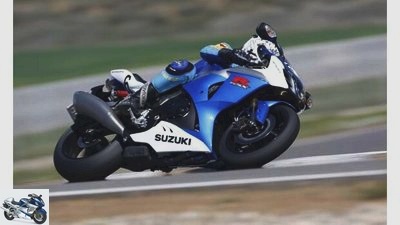
K
Suzuki GSX-R 1000.
Fourth day, 11 a.m. Start of the race. Start out of the box. Uwe sprints off on the 750 and plows his way through the field every lap. Respect. The time monitor later certifies his personal best in Turn 1 on the three-quarter-liter Gixxer. After 30 minutes he comes into the box, mounts the transponder on my 600 series, and pats me on the back. I drive off. My first race.
There is little activity on the route. I give everything – and after just three laps I am completely exhausted. Should I do that for three turns? I start to doubt. After another three laps, the pressure point of the 600 decreases. The first racers are pushing past me. Don’t give up, the driver change is soon. There, the sign. I drive into the box, change the transponder to Uwe’s 1000 and fall exhausted into a folding chair. Seldom have a 30-minute break been so relaxing.
I am back on the motorcycle far too quickly and Uwe sends me out of the box. It’s the 750’s turn. As in training, it is a lot of fun, although I am more and more exhausted. I enjoy the pressure from the corners, overtake some pilots, get overtaken and feel like a racing driver for the first time. Cool. I also do my fastest lap on the 750cc.
Change. Uwe drives out on the 600. I’m flat Who actually had the idea that I would end up riding the most powerful motorcycle? After 30 minutes I wave Uwe into the pits. He doesn’t see me and drives on. The same game in the next round. He only comes in on the third attempt.
I have 15 minutes left on the thousand. With an evil look and inner gratitude, I reprimand Uwe for the quarter of an hour that he stole my driving time. I drag myself across the track, hesitantly accelerate, brake earlier and struggle with the significantly poorer handling of the thousands. Keep up. The thousand takes my weakness calmly and can be circled around the course at a moderate pace with clean responsiveness and a lot of pressure. It’s nice that a fast motorcycle can also be slow.
Finally: the checkered flag. I drive into the pits, relieved and deeply satisfied. Uwe cheers, names me a racer with Spanish mineral water and knocks on the GSX-R tank. “Well done!” Does he mean the motorcycle or me? I don’t care either, I’m happy.
Data Suzuki GSX-R 600
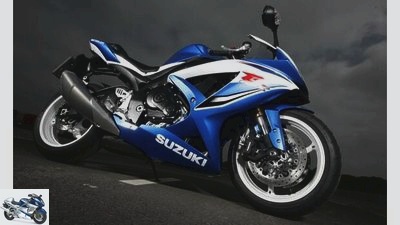
K
Suzuki GSX-R 600.
Suzuki GSX-R 600
Drive: Four-cylinder in-line engine, 4 valves / cylinder, 92.0 kW (125 PS) at 13500 / min *, 68 Nm at 11500 / min *, 599 cm³, bore / stroke: 67.0 / 42.5 mm, compression ratio: 12 , 5: 1, ignition / injection system, 40 mm throttle valves, mechanically operated multi-disc anti-hopping oil bath clutch, six-speed gearbox, G-Kat
Landing gear: Light alloy bridge frame, steering head angle: 66.2 degrees, caster: 97 mm, wheelbase: 1400 mm, upside-down fork, Ø fork inner tube: 41 mm, adjustable in spring base, rebound and compression damping, central spring strut with deflection, adjustable in spring base, Rebound and compression damping, spring travel v./h .: 120/130 mm
Wheels and brakes: Light alloy cast wheels, 3.50 x 17″/5.50 x 17″, Front tires: 120/70 ZR 17, rear: 180/55 ZR 17, initial tires: Bridgestone BT 016 “M.”, 310 mm double disc brake with four-piston fixed calipers at the front, 220 mm single disc with single-piston floating caliper at the rear
Measurements and weight: Length / width / height: 2020/800/1090 mm, seat / handlebar height: 820/860 mm, handlebar width: 630 mm, 186 kg fully fueled, v./h .: 51.0 / 49.0%
Rear wheel power in last gear: 81 kW (110 PS) at 233 km / h
Driving performance: Acceleration 0-100 / 150/200 km / h: 3.4 / 5.9 / 10.1 s, pulling speed 50-100 / 100-150 km / h: 6.3 / 5.8 s
Top speed: 260 km / h *
Consumption: Fuel type: Super, Average test consumption: ns. A., tank capacity / of which reserve: 17 / k. A. liters, range: n / a A..
Base price: 10990 Euro (plus ancillary costs)
* Factory specification
Data Suzuki GSX-R 750
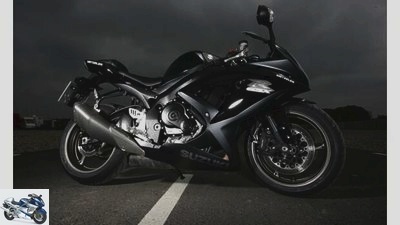
K
Suzuki GSX-R 750.
Suzuki GSX-R 750
Drive: Four-cylinder in-line engine, 4 valves / cylinder, 110.3 kW (150 PS) at 13200 / min *, 86 Nm at 11200 / min *, 750 cm³, bore / stroke: 70.0 / 48.7 mm, compression ratio: 12 , 5: 1, ignition / injection system, 42 mm throttle valves, mechanically operated multi-disc anti-hopping oil bath clutch, six-speed gearbox, G-Kat
Landing gear: Light alloy bridge frame, steering head angle: 66.3 degrees, caster: 97 mm, wheelbase: 1400 mm. Upside-down fork, Ø fork inner tube: 41 mm, adjustable in spring base, rebound and compression damping, central spring strut with deflection, adjustable in spring base, rebound and compression damping, spring travel v./h .: 120/130 mm
Wheels and brakes: Light alloy cast wheels, 3.50 x 17″/5.50 x 17″, Front tires: 120/70 ZR 17, rear: 180/55 ZR 17. First tires: Bridgestone BT 016 “E.”, 310 mm double disc brake with four-piston fixed calipers at the front, 220 mm single disc with single-piston floating caliper at the rear
Measurements and weight: Length / width / height: 2060/800/1120 mm, seat / handlebar height: 810/845 mm, handlebar width: 660 mm, 202 kg fully fueled, v./h .: 51.5 / 48.5%
Rear wheel power in last gear: 95 kW (129 PS) at 262 km / h
Driving performance: Acceleration 0-100 / 150/200 km / h: 3.2 / 5.3 / 8.7 s, pulling speed 50-100 / 100-150 km / h: 5.2 / 4.9 s
Top speed: 280 km / h *
Consumption: Fuel type: Super. Average test consumption: k. A., tank capacity / of which reserve: 17 / k. A. liters, range: n / a A..
Base price: 12,150 Euro (plus ancillary costs)
* Factory specification
Data Suzuki GSX-R 1000
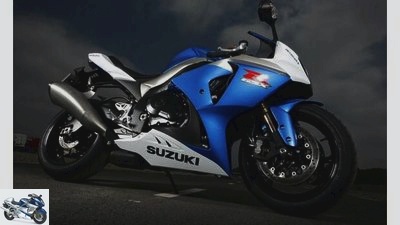
K
Suzuki GSX-R 1000.
Suzuki GSX-R 1000
Drive: Four-cylinder in-line engine, 4 valves / cylinder, 136 kW (185 PS) at 12000 / min *, 117 Nm at 10000 / min *, 999 cm³, bore / stroke: 74.5 / 57.3 mm, compression ratio: 12.5 : 1, ignition / injection system, 44 mm throttle valves, mechanically operated multi-disc anti-hopping oil bath clutch, six-speed gearbox, G-Kat
Landing gear: Light alloy bridge frame, steering head angle: 66.5 degrees, caster: 98 mm, wheelbase: 1405 mm, upside-down fork, Ø fork inner tube: 43 mm, adjustable spring base, rebound and compression damping. Central spring strut with deflection, adjustable in spring base, rebound and compression damping, spring travel v./h .: 125/130 mm
Wheels and brakes: Light alloy cast wheels, 3.50 x 17″/6.00 x 17″, Front tires: 120/70 ZR 17, rear: 190/50 ZR 17, initial tires: Bridgestone BT 016 “N”, 310 mm double disc brake with four-piston fixed calipers at the front, 220 mm single disc with single-piston floating caliper at the rear
Measurements and weight: Length / width / height: 2120/970/1150 mm, seat / handlebar height: 810/860 mm, handlebar width: 635 mm, 208 kg fully fueled, v./h .: 51.0 / 49.0%
Rear wheel power in last gear: 120 kW (163 PS) at 251 km / h
Driving performance: Acceleration 0-100 / 150/200 km / h: 3.2 / 5.2 / 7.6 s, pulling speed 50-100 / 100-150 km / h: 4.5 / 4.1 s
Top speed: 295 km / h *
Consumption: Fuel type: Super, Average test consumption: ns. A., tank capacity / of which reserve: 17.5 / 4.6 liters, range: ns. A..
Base price: 13890 Euro (plus additional costs)
* Factory specification
Conclusion
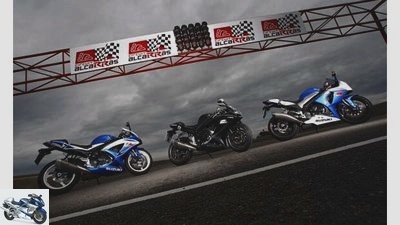
K
Suzuki GSX-R 600, 750 and 1000.
Conclusion: Both drivers got along best in the 3-hour race with the GSX-R 750 and drove it faster than with the new 1000. The easily controllable, full power development combined with the handling of the 600 make the middle of the three sisters a tip for hobby racers.
The thousand is for professionals. Anyone who wants to optimally implement their performance has to be tough.
The 600 series has the hardest time in this three-way battle: it does everything well, but loses connection a little due to the displacement disadvantage.
Related articles
-
Honda Fireblade, Kawasaki Ninja ZX-10R, Suzuki GSX-R 1000, Yamaha YZF-R1
fact 28 pictures Honda 1/28 Honda 2/28 Honda 3/28 Honda 4/28 Honda 5/28 Honda 6/28 Honda 7/28 Honda 8/28 Honda 9/28 Honda 10/28 Honda 11/28 Honda 12/28…
-
fact motorcycles Comparison test: Honda CBR 600 RR, Kawasaki ZX-6R, Suzuki GSX-R 600, Triumph Daytona 675, Yamaha YZF-R6 Comparison test: Honda CBR 600…
-
Jahn 31 pictures Photos: fact / Jahn 1/31 Honda Fireblade, Kawasaki Ninja ZX-10R, Suzuki GSX-R 1000, Yamaha YZF-R1, Ducati 1198S, KTM 1190 RC8 R and…
-
Honda CBR 600 RR, Kawasaki Ninja ZX-6R, Suzuki GSX-R 600, Triumph Daytona 675, Yamaha YZF-R6
Jahn 15th pictures Honda 1/15 For the model year 2009 Honda presents a facelifted CBR 600 RR. The well-known 600 cubic four-cylinder has been trimmed for…
-
Tuning and conversion guide Suzuki GSX-R 1000
Andreas Feulner 15th pictures Feulner 1/15 Performance and electronics – in these areas Suzuki has neglected the GSX-R 1000 badly. Nevertheless, it is…
-
Suzuki motorcycles Premiere: Suzuki GSX-R 600 Premiere: Suzuki GSX-R 600 Full house Content of The Supersport class is complete; Suzuki has rolled the…
-
Recall Suzuki GSX-R 1000 model year 2017 – 2018
Suzuki 15th pictures 1/15 In 1994 two different variants of a Suzuki top superbike were fired for the last time from their pipes. Is the surcharge for…
-
Concept comparison: Honda Fireblade, KTM 990 Super Duke R, Suzuki GSX-R 600, Yamaha FZ6
Gargolov motorcycles Concept comparison: Honda Fireblade, KTM 990 Super Duke R, Suzuki GSX-R 600, Yamaha FZ6 Concept comparison: Honda Fireblade, KTM 990…
-
Comparison test: Suzuki Hayabusa old against new
motorcycles Comparison test: Suzuki Hayabusa old against new Comparison test: Suzuki Hayabusa old against new Shoot out boys! Content of Hayabusa, the…
-
Jahn motorcycles Top test Suzuki Bandit 650 S Top test Suzuki Bandit 650 S The trick with the pressure The Suzuki Bandit 650 S beats the competition with…